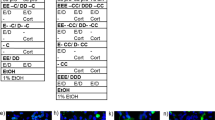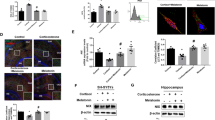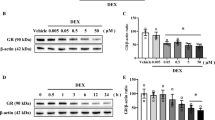Abstract
Glucocorticoid (GC) hormones, increased in response to stress, can cause neuronal loss. We tested the effect of GC hormone on cell viability of neural SHSY-5Y cells and protective effects of ginsenoside Rb1 and Rg3 on the action of GC. We treated SHSY-5Y cells with increasing concentrations of synthetic GC dexamethasone (DEX; 10, 25, 50, and 100 nM) for 24 and 48 h, and then determined cell viability by using MTT assay. We then treated SHSY-5Y cells with DEX (100 nM) with or without the ginsenosides to examine their preventive effects on the cytotoxicity. To explore the underlying molecular mechanisms, we measured mRNA expression of bax and bcl-2 by using reverse transcriptase real-time PCR. SHSY-5Y cells treated with DEX significantly reduced cell viability as compared with control cells. In the presence of Rb1 or Rg3, DEX-induced cytotoxicity was effectively blocked. DEX considerably increased pro-apoptotic bax mRNA expression as compared with control cells. However, Rb1 and Rg3 completely blocked DEX-mediated up-regulation of bax expression. DEX significantly increased neuronal death in organotypic hippocampal slice cultures of rat brain with enhanced generation of ROS, which was effectively inhibited by ginsenoside Rb1 and Rg3. This suggests a potential role of the ginsenosides to target GC action in the brain.





Similar content being viewed by others
References
Abidin I, Yargicoglu P, Agar A, Gumuslu S, Aydin S, Ozturk O, Sahin E (2004) The effect of chronic restraint stress on spatial learning and memory: relation to oxidant stress. Int J Neurosci 114:683–699
Almeida OFX, Conde GL, Crochemore C, Demeneix BA, Fischer D, Hassan AHS, Meyer M, Holsboer F, Michaelidis TM (2000) Subtle shifts in the ration between pro- and antiapoptotic molecules after activation of corticosteroid receptors decide neuronal fate. FASEB J 14:779–790
Bae EA, Hyun YJ, Choo MK, Oh JK, Ryu JH, Kim DH (2004) Protective effect of fermented red ginseng on a transient focal ischemic rats. Arch Pharm Res 27:1136–1140
Benishin CG, Lee R, Wang LC, Liu HJ (1991) Effects of ginsenoside Rb1 on central cholinergic metabolism. Pharmacol 42:223–229
Carr MN, Bekku N, Yoshimura H (2006) Identification of anxiolytic ingredients in ginseng root using the elevated plus-maze test in mice. Eur J Pharmacol 531:160–165
Chen F, Eckman EA, Eckman CB (2006) Reductions in levels of the Alzheimer’s amyloid beta peptide after oral administration of ginsenosides. FASEB J 20:1269–1271
Kim DH, Jung JS, Suh HW, Huh SO, Min SK, Son BK, Park JH, Kim ND, Kim YH, Song DK (1998a) Inhibition of stress-induced plasma corticosterone levels by ginsenosides in mice: involvement of nitric oxide. Neuroreport 9:2261–2264
Kim YC, Kim SR, Markelonis GJ, Oh TH (1998b) Ginsenosides Rb1 and Rg3 protect cultured rat cortical cells from glutamate-induced neurodegeneration. J Neurosci Res 53:426–432
Lee SH, Jung BH, Choi SY, Kim SY, Lee EH, Chung BC (2006a) Influence of ginsenoside Rb1 on brain neurosteroid during acute immobilization stress. Arch Pharm Res 29:566–569
Lee SH, Jung BH, Kim SY, Lee EH, Chung BC (2006b) The anti-stress effect of ginseng total saponin ginsenoside Rg3 and Rb1 evaluated by brain polyamine level under immobilization stress. Pharmacol Res 54:46–49
Lian XY, Zhang Z, Stringer JL (2006) Anticonvusant and neuroprotective effects of ginsenosides in rats. Epilepsy Res 70:244–256
Lim JH, Wen TC, Matsuda S, Tanaka J, Maeda N, Peng H, Aburaya J, Ishihara K, Sakanaka M (1997) Protection of ischemic hippocampal neurons by ginsenoside Rb1, a main ingredient of ginseng root. Neurosci Res 28:191–200
Macklis JD, Madison RD (1990) Progressive incorporation of propidium iodide in cultured mouse neurons correlates with declining electrophysiological status: a fluorescence scale of membrane integrity. J Neurosci Methods 31:43–46
Macleod MR, Allsopp TE, McLuckie J, Kelly JS (2001) Serum withdrawal causes apoptosis in SHSY-5Y cells. Brain Res 889:308–315
McEwen BS (2000) The neurobiology of stress: from serendipity to clinical relevance. Brain Res 886:172–189
McIntosh LJ, Sapolsky RM (1996) Glucocorticoids increase the accumulation of reactive oxygen species and enhance adriamycin-induced toxicity in neuronal culture. Exp Neurol 141:201–206
Mook-Jung I, Hong HS, Boo JH, Lee KH, Yun SH, Cheong MY, Joo I, Huh K, Jung MW (2001) Ginsenoside Rb1 and Rg1 improve spatial learning and increase hippocampal synaptophysin level in mice. J Neurosci Res 63:509–515
Ohashi R, Yan S, Mu H, Chai H, Yao Q, Lin PH, Chen C (2005) Effects of homocysteine and ginsenoside Rb1 on endothelial proliferation and superoxide anion production. J Surg Res 133:89–94
Oluwatosin-Chigbu Y, Robbins A, Scott CW, Arriza JL, Reid JD, Zysk JR (2003) Parkin suppresses wild-type α-synuclein-induced toxicity in SHSY-5Y cells. Biochem Biophys Res Commun 309:679–684
Park JK, Namgung U, Lee CJ, Park JO, Jin SH, Kwon OB, Ko SR, Kim SW, Kang EJ, Ko JH, Lee SM, Kim DH, Won MH (2005) Calcium-independent CaMKII activity is involved in ginsenoside Rb1-mediated neuronal recovery after hypoxic damage. Life Sci 76:1013–1025
Pfaffl MW, Horgan GW, Dempfle L (2002) Relative expression software tool (REST) for group-wise comparison and statistical analysis of relative expression results in real-time PCR. Nucleic Acids Res 30:e36
Radad K, Gille G, Moldzio R, Saito H, Rausch WD (2004) Ginsenosides Rb1 and Rg1 effects on mesencephalic dopaminergic cells stressed with glutamate. Brain Res 1021:41–53
Richeux F, Cascante M, Ennamany R, Saboureau D, Creppy EE (1999) Cytotoxicity and genotoxicity of capsaicin in human neuroblastoma cells SHSY-5Y. Arch Toxicol 73:403–409
Rudakewich M, Ba F, Benishin CG (2001) Neurotrophic and neuroprotective actions of ginsenosides Rb(1) and Rg(1). Planta Med 67:533–537
Salim KN, McEwen BS, Chao HM (1997) Ginsenoside Rb1 regulates ChAT, NGF, and trkA mRNA expression in the rat brain. Mol Brain Res 47:177–182
Sapolsky RM (1996) Why stress is bad for your brain. Science 273:749–750
Sapolsky RM, Romero LM, Munck AU (2000) How do glucocorticoids influence stress responses? Integrating permissive, suppressive, stimulatory, and preparative actions. Endocr Rev 21:55–89
Stoppini L, Buchs PA, Muller D (1991) A simple method for organotypic cultures of nervous tissue. J Neurosci Methods 37:173–182
Wagle A, Singh JP (2000) Fibroblast growth factor protects nitric oxide-induced apoptosis in neuronal SHSY-5Y cells. J Pharmacol Exp Ther 295:889–895
Woolley CS, Gould E, McEwen BS (1990) Exposure to excess glucocorticoids alters dendritic morphology of adult hippocampal pyramidal neurons. Brain Res 531:225–231
You JM, Yun SJ, Nam KN, Kang C, Won R, Lee EH (2009) Mechanism of glucocorticoid-induced oxidative stress in rat hippocampal slice cultures. Can J Physiol Pharmacol 87:440–447
Yun SJ, Lee DJ, Kim MO, Jung B, Kim SO, Sohn NW, Lee EH (2003) Reduction but not cleavage of poly(ADP-ribose) polymerase during stress-mediated cell death in the rat hippocampus. Neuroreport 14:935–939
Acknowledgment
This study was supported by research program of Korea Food Research Institute.
Author information
Authors and Affiliations
Corresponding author
Rights and permissions
About this article
Cite this article
Kim, SO., You, JM., Yun, SJ. et al. Ginsenoside Rb1 and Rg3 Attenuate Glucocorticoid-Induced Neurotoxicity. Cell Mol Neurobiol 30, 857–862 (2010). https://doi.org/10.1007/s10571-010-9513-0
Received:
Accepted:
Published:
Issue Date:
DOI: https://doi.org/10.1007/s10571-010-9513-0




